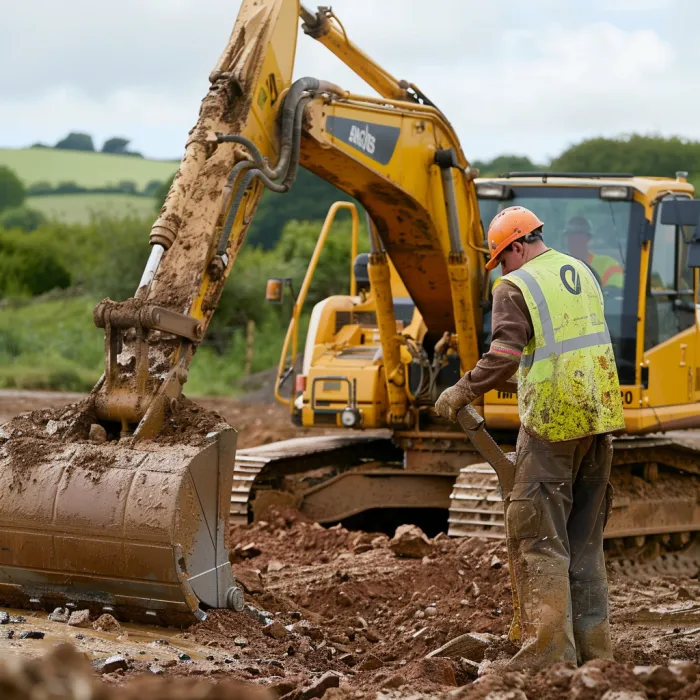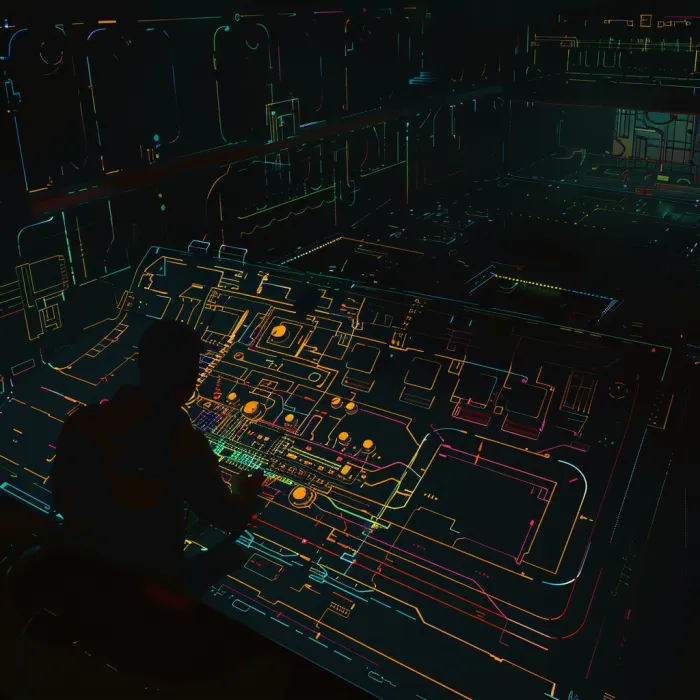
What are Machine Control Models?
Machine control models are digital 3D representations of construction sites, designed to guide and optimiSe the operation of heavy machinery equipped with GPS or other positioning systems.
These models provide precise, real-time information to machine operators, enabling them to work more accurately, efficiently, and safely.


Use Cases for Models of Machine Control
By providing highly precise 3D representations of construction sites, machine control models have revolutionised the construction industry by enabling heavy machinery to operate with greater precision and efficiency. These models are adaptable and can be implemented in heavy highway and civil infrastructure construction as well as commercial and residential developments. Consider a few of the most prevalent applications of machine control models
.
Commercial Projects
Industrial facilities, office structures, and retail establishments are among the most common commercial applications of machine control models. Frequently, these endeavours necessitate intricate foundation work, excavation, and grading, all of which demand precise guidance for heavy machinery. By employing machine control models, contractors can reduce the likelihood of errors and rework by ensuring that earthwork and grading are executed precisely and efficiently.
Residential or Housing Plot Projects
Additionally, machine control models find extensive application in residential construction endeavours, encompassing individual home sites, apartment complexes, and subdivisions. The machinery involved in activities such as grading lots, excavating foundations, and constructing roads and drainage systems can be guided by these models. Machine control models are utilised in both small-scale developments and expansive 500-lot subdivisions to guarantee that every element of the undertaking is constructed in accordance with exacting specifications, ultimately culminating in a product of superior quality.
Highway or Road Construction
The heavy highway and Roads industry has benefited substantially from the implementation of machine control models. For the purpose of directing machinery during the construction of roads, highways, and bridges, these models guarantee precise and seamless paving, alignment, and grading. Machine control models have assumed greater significance as an increasing number of contractors adopt stringless paving methods. These models furnish the paving equipment with the essential three-dimensional guidance required to attain the intended surface uniformity and ride quality.
Significant civil infrastructure
In light of global efforts to update infrastructure, machine control models have emerged as indispensable instruments in the realm of major civil construction. By providing guidance to machinery during the construction of rail yards, airports, harbours, and dams, these models guarantee the ultimate precision in the execution of intricate grading and excavation operations. Machine control models assist contractors in overcoming the obstacles of heavy civil construction and completing projects timely and within budget, ranging from straightforward excavation to complex rail yard rebuilds.
Key aspects of machine control models include
- Accurate terrain representation: Machine control models are built using detailed survey data, ensuring that the digital model closely matches the real-world site conditions. This accurate representation of the terrain allows machine operators to work with confidence, knowing that the model is guiding them precisely.
- Compatibility with machine control systems: These 3D models are designed to integrate seamlessly with various machine control systems, such as Leica, Trimble, and Topcon. This compatibility ensures that the model data can be easily loaded into the machine's onboard computer, providing the operator with real-time guidance and feedback.
- Improved efficiency and productivity: By using machine control models, operators can work more quickly and accurately, reducing the need for manual surveying and stakeout. This increased efficiency translates to faster project completion times and lower labor costs.
- Reduced errors and rework: With precise 3D models guiding the machinery, the risk of errors and inaccuracies is significantly reduced. This means less time and resources spent on correcting mistakes and reworking sections of the site, ultimately leading to cost savings and improved project outcomes.
- Enhanced safety: Machine control models help operators maintain a clear understanding of their position relative to the design, as well as the location of other site features and hazards. This heightened awareness promotes a safer working environment for all personnel on the construction site.
In summary, machine control models are essential tools for modern construction projects, enabling heavy machinery to operate with greater precision, efficiency, and safety. By leveraging these digital 3D representations of construction sites, contractors and machine operators can streamline their workflows, reduce costs, and achieve superior results.
What are machine control models used for?
Machine control models are used by site engineers to plan and guide construction activities, while machine operators use them to accurately execute grading, excavation, paving, and utility installation tasks. These models help construction professionals work more efficiently, reduce errors, and ensure that the project is completed according to the designed specifications.
Site preparation and grading:
- Site engineers use machine control models to plan and guide the grading process, ensuring that the site is leveled and prepared according to the project's specifications.
- Machine operators, such as dozer and grader operators, use the models loaded into their machine control systems to accurately grade the site, following the precise design elevations and contours provided by the model.
Excavation and earthwork:
- Excavator operators use machine control models to guide their digging and trenching work, ensuring that they excavate to the correct depths and follow the designed profiles for foundations, utilities, and other below-ground structures.
- The models help operators maintain accurate grades and slopes, minimizing over-excavation and reducing the need for rework.
Paving and surfacing:
- Paver operators use machine control models to guide the placement and compaction of asphalt or concrete layers for roads, parking lots, and other paved surfaces.
- The models ensure that the paving work adheres to the designed elevations, cross-slopes, and transitions, resulting in a smooth and consistent surface that meets the project's specifications.
Drainage and utilities:
- Machine control models guide excavator and trencher operators in digging trenches for drainage systems, water lines, and other utilities.
- The models provide accurate information on the designed invert elevations, grades, and alignments, ensuring that the utilities are installed correctly and efficiently.
Quality control and as-built documentation:
- Site engineers and surveyors use machine control models as a reference for quality control checks, comparing the as-built conditions to the designed model to verify that the work meets the required tolerances.
- The models also serve as a basis for creating as-built documentation, which captures the final constructed state of the project for future reference and maintenance purposes.
How are machine control models made?
Machine control models are created using a combination of survey data, design information, and specialised software. The process typically involves data collection, softwear processing, model refinement and file conversion, before presenting to the client.
- Data collection: Surveyors use advanced equipment, such as GPS, total stations, and 3D laser scanners, to gather precise data about the existing site conditions, including terrain, boundaries, and existing structures.
- Design integration: The survey data is combined with the project's design information, such as CAD plans, to create a comprehensive 3D model of the site.
- Software processing: Specialised software, such as Trimble Business Center or Topcon Magnet Office, is used to process the survey data and design information, creating a highly accurate 3D model of the construction site.
- Model refinement: The 3D model is reviewed and refined to ensure it meets the project's specific requirements and is free of errors or inconsistencies.
- File conversion: The final machine control model is converted into the appropriate file formats compatible with the specific machine control systems being used on the project, such as Leica, Trimble, or Topcon.
The creation of machine control models requires a high level of expertise and attention to detail to ensure the final product is accurate, reliable, and suitable for use in guiding heavy machinery on construction sites.
What software is needed for machine control models?
Various specialised software is used in the creation and management of machine control models. Some of the most common software packages include:
- Trimble Business Center: A comprehensive software solution for surveying, engineering, and construction, which enables users to process survey data, create 3D models, and generate files for machine control systems.
- Topcon Magnet Office: An all-in-one software solution for surveying, mapping, and construction, which allows users to process survey data, create and edit 3D models, and export files for machine control.
- Leica iCON office: A powerful software package designed for construction professionals, which enables the creation, editing, and management of 3D models and the generation of machine control files.
- AutoCAD Civil 3D: A widely used civil engineering and design software that allows users to create and edit 3D models, perform grading and earthwork calculations, and generate data for machine control.
- Bentley OpenRoads Designer: An advanced software solution for road and highway design, which enables users to create and manage 3D models, perform grading and drainage analysis, and generate files for machine control.
In addition to these main software packages, various other specialised tools and plugins may be used depending on the specific requirements of the project and the machine control systems being employed. The choice of software depends on factors such as the project's complexity, the surveying and design data available, and the preferences of the professionals creating the machine control models.